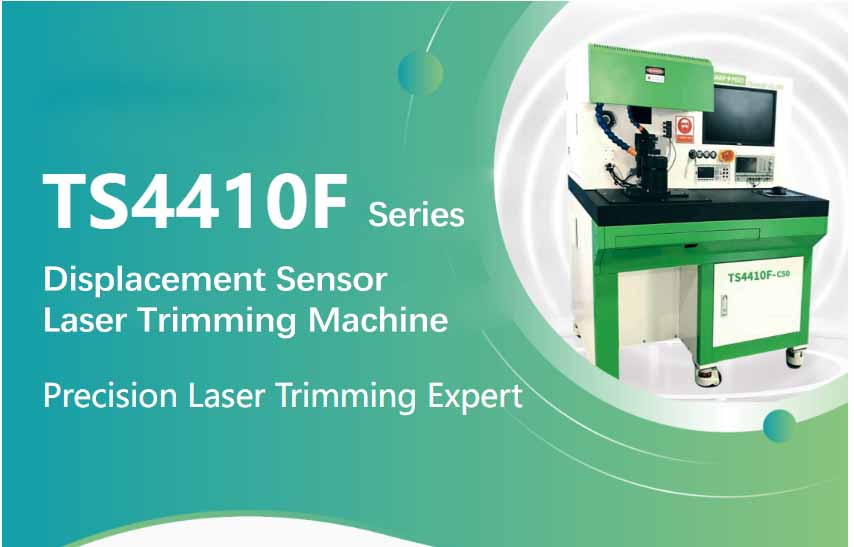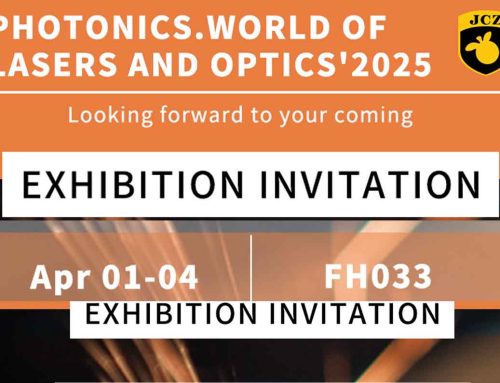TS4410F Series
Displacement Sensor Laser Trimming Machine

Device Principle

The accuracy of the resistor board determines the linear accuracy of the sensor. Trimming the initial linearity of the resistor board can improve the measurement precision of the sensor. Through linear trimming, part of the conductive carbon film is removed, adjusting the sensor’s output curve to meet the required linear accuracy for the resistance-displacement curve.
Traditional Trimming Process:
Manual trimming involves technicians using handheld knives to make uneven cuts along the edges of the resistor board. This method relies on the experience and skill of the operator. The process has low precision, low success rates, and is inefficient, making it unsuitable for mass production. Currently, this process has largely been replaced by automatic milling cutters and high-precision laser trimming.
High-speed milling cutters etch and adjust the resistance on the carbon film surface of the resistor board, but the contact causes conductive phenomena that lead to measurement data deviations, which cannot be accurately controlled. Over time, repeated use of the milling tool causes wear, affecting the linear precision of the resistor board trimming.
The linearity between the sensor’s output signal and the measured physical quantity is typically expressed as a percentage or the maximum error. The linearity of the sensor refers to the deviation between the sensor’s measured value and the true displacement value of the measured position.
Our Laser Trimming Process:
Our new laser processing technology uses a laser beam to focus on the carbon film surface of the resistor board, rapidly melting and evaporating the material to change the effective conductive area of the resistor board, thereby adjusting the unit resistance value. The laser trimming technology is a non-contact process, eliminating the issue of tool wear. The laser beam’s energy and speed are adjustable, and during the processing, the spot temperature can exceed 10,000°C, allowing for precision vaporization processing without affecting the mechanical properties of the surrounding materials.
Additionally, the laser beam is easily guided and can be integrated with CNC systems for fine processing of precision materials. The application of laser trimming technology in sensor processing significantly improves the linear accuracy of linear displacement sensors.
T54410F Series
Linear Displacement Sensor Laser Trimming Machine


T54410F Series
Linear Displacement Sensor Laser Trimming Machine

Laser Trimming for Angular Displacement Sensors
Compared to traditional manufacturing processes, the advantage of laser trimming lies in the laser’s small spot size and high energy characteristics. These features allow laser trimming to process smaller angular displacement sensors, with the smallest potentiometer diameter being as small as 7mm. At the same time, in terms of linearity accuracy, laser trimming enables higher resolution processing, significantly improving the overall accuracy of the displacement sensor and meeting the current market demand for smaller and higher-precision sensors.
The Laser Trimming Machine is a key device that uses laser technology to etch thin-film or thick-film resistors, enabling precise electrical signal adjustments. In the production of mobile devices such as mobile terminals, digital cameras, and portable machines, the use of precision laser trimming machines as processing equipment has significant development potential.
Our self-developed TS4410F series Displacement Sensor Laser Trimming Machine, launched in 2013, is a precision laser trimming machine developed for the resistive angular/linear displacement sensor market. It can adjust both independent linearity and absolute linearity of products. This equipment is widely applicable for laser trimming of various precision potentiometers (plastic-conductive/ceramic), displacement sensors, and other products.
Device Features
Easy-to-Use Software
Our self-developed Trim Linear resistor trimming software system, combined with our unique laser trimming technology, is powerful yet simple to operate. It allows for precise point adjustments at any angle and manual trimming operations. It can be customized to meet customers’ specific trimming methods and process requirements.
High Production Efficiency
Our self-developed coaxial video system, coupled with a high-resolution industrial camera, enables automatic alignment and correction, reducing human error and improving production efficiency.
Powerful Device Functions
Equipped with our self-developed high-precision measurement and control system, the device offers strong functionality and scalability, meeting a wide range of customer needs.
Symmetry Trimming
Trimming can start from any angle as the central reference, allowing for symmetric resistance trimming. The minimum measurement accuracy for angles is 2′.
Arbitrary Target Curve Resistance Trimming
The machine can perform curve trimming for any function within a specified angle range, ensuring smooth transitions between different segments.
Why Choose Us
The simplified structure enables real-time closed-loop control for non-contact processing, significantly improving processing accuracy. The linearity is more uniform, and resistance control is more precise. The technology ensures the sliding output voltage of the wiper on the potentiometer is smoother. The degree of trimming at each point is more accurate than manual or high-speed milling machines. Typically, manual trimming has a resistance error of around 15%, while laser trimming can achieve an accuracy of up to 0.1%, significantly reducing resistance errors. The laser’s excellent directionality ensures high precision and reliability in measurements and trimming, while also achieving modularity and simplicity in the system. The thermal deformation and heat-affected zones on the substrate are minimal, improving processing efficiency. The linear accuracy is high, reaching advanced levels of up to 0.04%.






